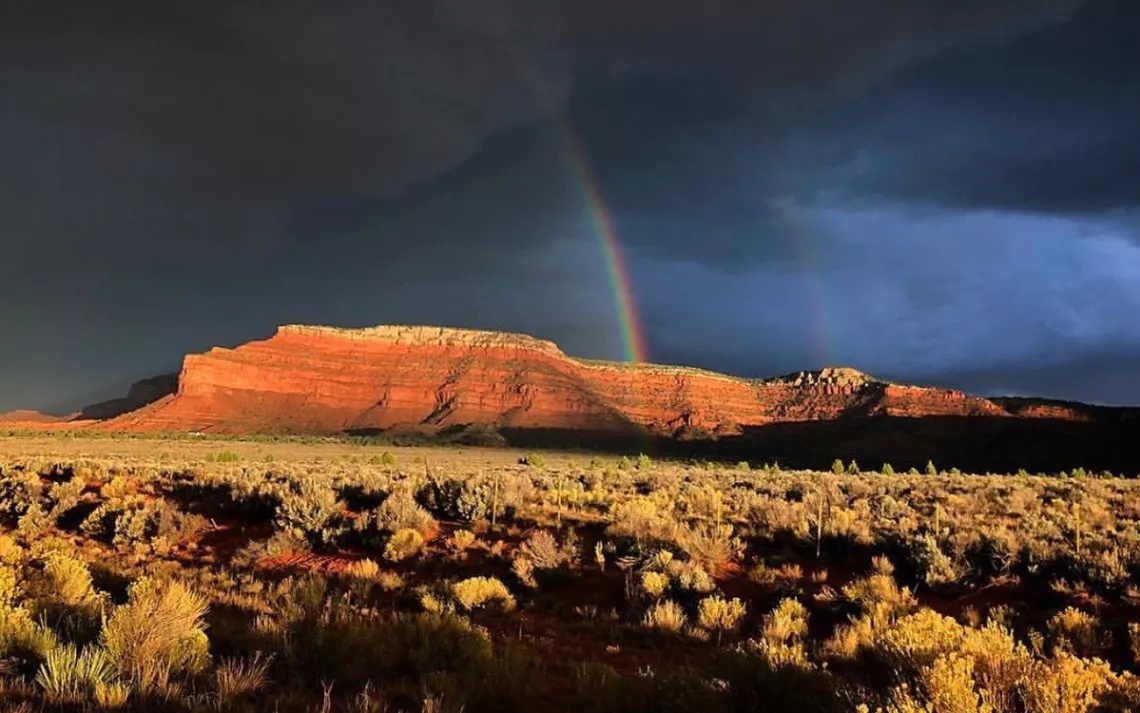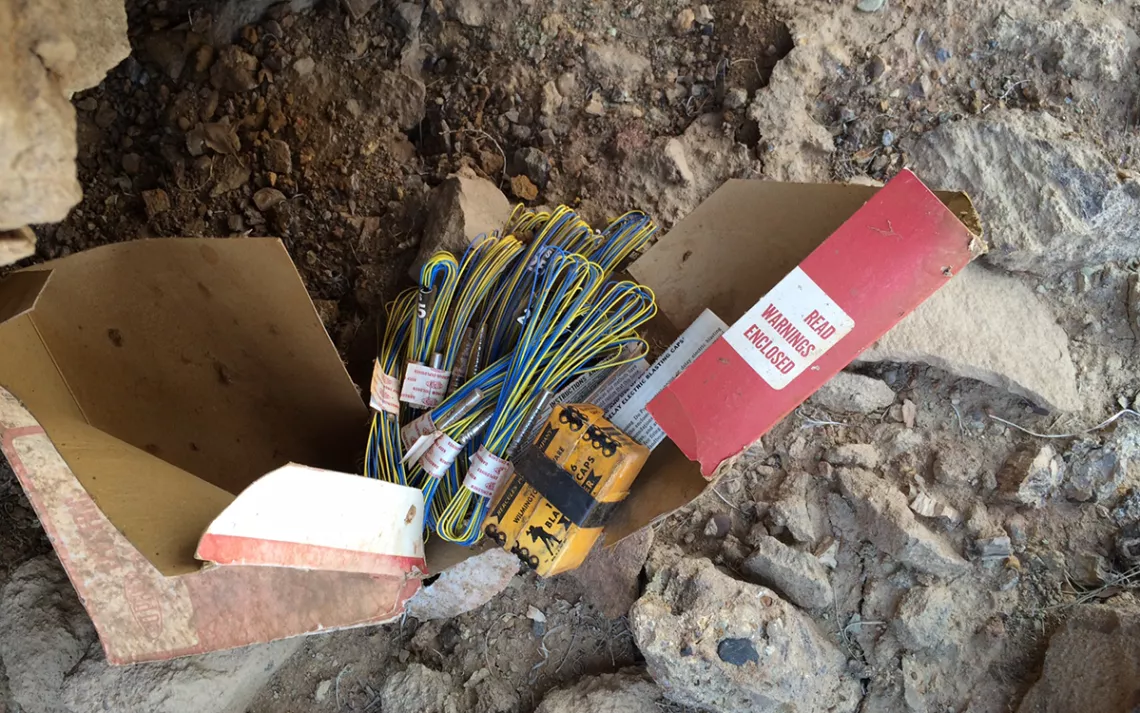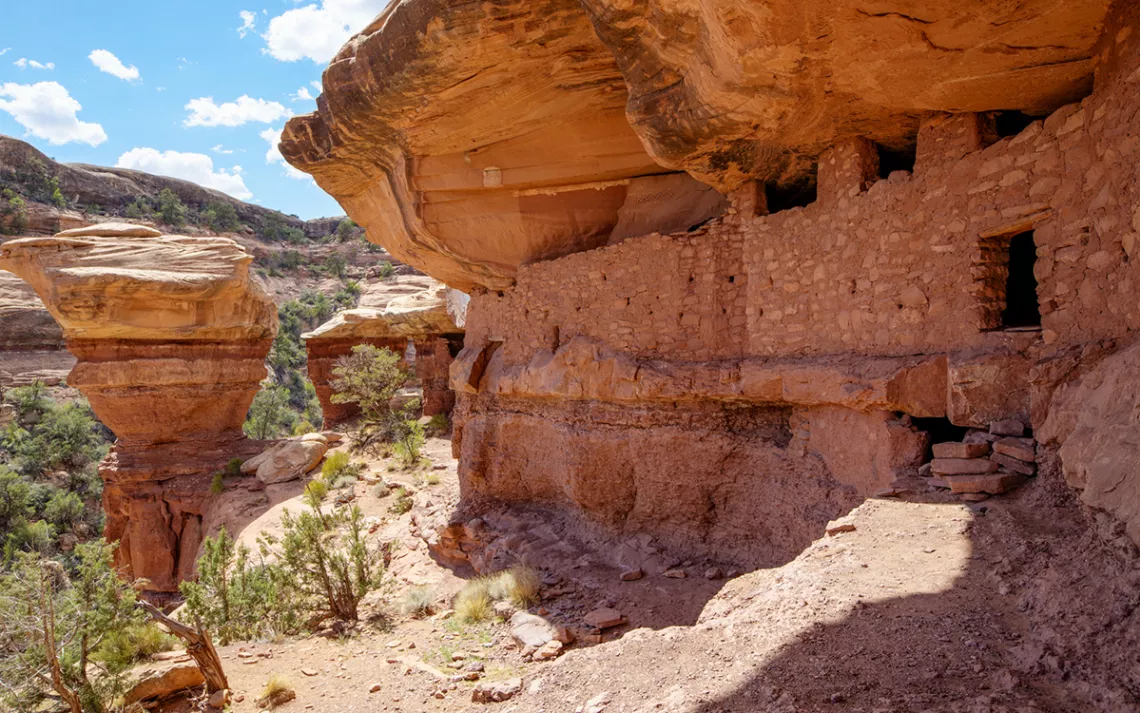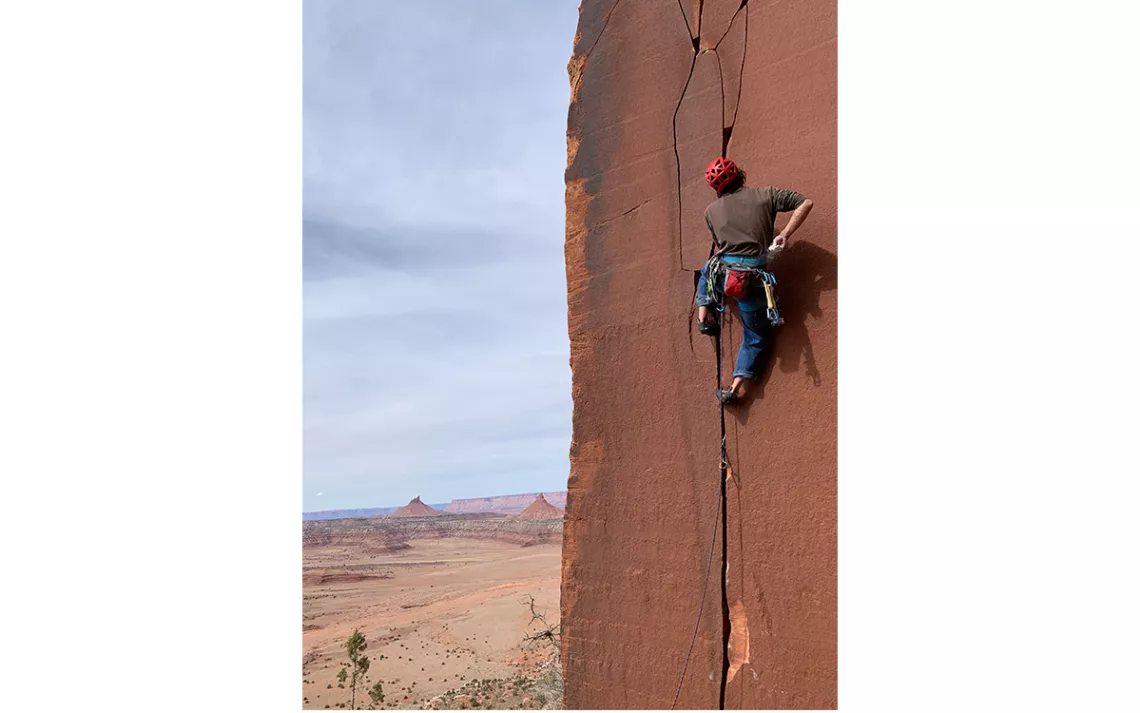Rock Climbers and Conservationists Unite Behind Indigenous Nations to Defend Bears Ears
An ad hoc coalition is working across cultural lines to defend southern Utah

Rainbow rising over a red mesa in Grand Staircase–Escalante National Monument. | Photo courtesy of Harry Barber/BLM
In May 2017, Luke Mehall, publisher of the Climbing Zine and the author of five books about rock climbing, was scouting new routes among the sandstone buttes of Indian Creek in southern Utah when he noticed something alarming. A small portion of the land had been blown apart, and lying atop a scattering of rocks was a box of old explosives. Not realizing what they were at first, Mehall moved them slightly, soon realizing his mistake. Shortly after that, Mehall noticed the start of an abandoned uranium exploratory mine. Mehall contacted the local Bureau of Land Management office, and a BLM official hiked out to the mine with Mehall to locate the explosives for eventual removal. The miners’ casual disregard for the landscape—not to mention public safety—served as a sharp reminder for Mehall about “why the industry has to be so heavily regulated.” Especially, he says, “on sacred lands where they shouldn't be allowed to mine or extract.”
Much of southern Utah’s sandstone slot canyons, high mesas covered in piñon and juniper, and blue-gray badlands were once protected as national monuments. In 1996, President Clinton established the vast Grand Staircase–Escalante National Monument, nearly 2 million acres of canyonlands floored with perennial streams and velvet ribbons of cottonwoods. In December 2016, President Obama created Bears Ears National Monument after a coalition of five southwestern Native American nations spearheaded a historic campaign to protect and comanage their ancestral lands. But two years ago, in an unprecedented move, President Trump ordered the near-abolishment of Bears Ears and a dramatic downsizing of Grand Staircase–Escalante. It was the largest rollback of protected public lands in US history.

Old explosives found by Mehall while scouting routes in Bears Ears during Spring 2017. | Photo courtesy of Luke Mehall
Now, the Trump administration is moving ahead with a plan that—if it withstands court challenges from Indigenous nations and conservation and outdoor recreation organizations—would allow for new oil, gas, and mineral extraction in the once-preserved landscapes. In February, Trump’s BLM released its finalized Monument Management Plans for Grand Staircase–Escalante as well as the remnant areas of Bears Ears—what the Trump administration is now calling Indian Creek and Shash Jáa units of the Bears Ears National Monument. The plan will permit fossil fuel and uranium mining companies to lease around 1 million acres of land in the former Bears Ears and Grand Staircase–Escalante National Monuments. Oil and gas companies have already submitted to the Interior Department 230 nominations for areas they would like to explore, stretching across some 150,000 acres of public lands. At least 30 tentative leases are within five miles of the original Bears Ears National Monument boundaries, with some as close as one mile to the monument.
The push for increased mineral development and fossil fuel exploration fits squarely within a larger effort by the Trump administration to use the pandemic as an opportunity to push through its long-standing extraction agenda. In March and early April, on the heels of a request from the American Petroleum Institute, the federal government eased permitting regulations in national forest lands for exploration, development, and mining, as well as temporarily eased EPA regulations on polluting industries such as the oil and gas industry.
The administration is also fast-tracking the leasing of oil and gas permits, and now offering noncompetitive leasing—resulting in a massive auctioning off of US public lands to the oil and gas industry at rock-bottom prices. In late April, the Energy Department released a report announcing that the government “will take bold action to revive and strengthen the uranium mining industry” while also calling for a loosening of “permitting and regulatory burdens.” Conservation groups say the administration’s push for expanded uranium mining threatens the landscapes of southern Utah, which are known to contain significant uranium deposits.
“Along with many other reasons, the Trump administration should rot in jail for the atrocities of shrinking the monument,” says Mehall, who has spent two decades climbing in the Bears Ears region and who, this spring, proposed to his fiancée at one of the area’s remote campsites. Feeling lost and angry following Trump’s election and the monument rollback, Mehall has tried to channel his energy into environmental activism to save Bears Ears.

Named after its lunar pictograph, the Moon House is a multiroom cliff dwelling on Cedar Mesa, dating to the 1200s A.D. It has been affected by looters who have swept the site of its artifacts and has been threatened by overuse from visitors. | Photo courtesy of Bob Wick/BLM

Dave Marcinowski on a route called Microdose in Indian Creek, Bears Ears National Monument | Photo courtesy of Luke Mehall
Mehall is part of an ad hoc coalition of rock climbers, scientists, Indigenous nations, conservationists, and ranchers fighting to defend the region from the Trump administration’s agenda. Each group holds different connections to the lands of southern Utah. For some, the high desert country is a place to play; for others, it is the site for sacred ceremonies passed down from ancestors; for others, it is a working landscape or a research site. But whether they are invested in the land for cultural, recreational, or scientific reasons, all agree that the former monuments should be preserved. Friends of Cedar Mesa, a local conservation group, and the Access Fund, a rock climbing organization, have joined Utah Diné Bikéyah and the Bears Ears Inter-Tribal Coalition in filing lawsuits against the proposed monument reductions. Those groups—along with nine national conservation organizations including the Sierra Club—argue that the Trump administration’s proposed rollback violates the Antiquities Act, and they have asked a federal court to put the monument management plans on hold while the case is being heard.
“For us, as Indigenous peoples, Bears Ears is the same as how some view churches,” says Alastair Bitsoi, communications director of Utah Diné Bikéyah. The Indigenous-led grassroots organization has been at the forefront of efforts to establish—and, now, defend—the area known as Bears Ears, which holds cultural and sacred significance to the Navajo, Hopi, Ute Mountain Ute, Ute Indian, and Pueblo Zuni nations (known collectively as the Five Tribes). Members of those nations have long used the territory for hunting and fishing, for gathering medicinal and sacred plants, and for cultural ceremonies that pay respect to their ancestors who have resided in those lands since time immemorial. “We have different histories, ceremonies, and worldviews, but there are also universal values across each of these unique cultures with connections to Bears Ears. That's the beauty of Bears Ears. There is not just one culture, society, or language that can fully emphasize how important this landscape is to all of us as Indigenous peoples, as humans.”
For non-Indigenous climbers like Mehall, the effort to defend Bears Ears and Grand Staircase–Escalante has led to a deeper understanding of the cultural connections, traditions, and values of Bears Ears to the Five Tribes and how the climbing community can support them in the fight to preserve the land. This understanding came into stark focus one day in April 2016, when Mehall completed the first ascent of a crack system rising to the top of a red sandstone butte that overlooked sagebrush, piñon pine, and juniper trees as far as he could see. Given how remote the rock formation was and the inaccessibility of the 400-foot sheer cliff face rising to the top of the pinnacle, Mehall and his climbing partner wondered, “Gosh, are we the first people to be here?”
“As I was thinking about it, I looked down and saw a bunch of beautiful pieces of broken pottery,” Mehall says. “It gave me goosebumps. A place where we thought we were maybe the first people to stand, people had stood 1,000 years ago, up 400 feet of sheer vertical rock, and must have carved Moki steps, surely risking their lives.” Moki steps are hand and toe holds carved into the steep sandstone walls by the Ancestral Puebloans so they could access cliff dwellings and storage areas. “The narrative a lot of times is the first climbers came along in the '60s and '70s,” Mehall says, “But truly the Ancestral Puebloans were the first climbers.”
“The tribes have been taking care of this place since time immemorial,” says Chris Winter, executive director of the Access Fund. “And so we view everything we do in Bears Ears through that lens of supporting the tribes’ leadership, and putting an emphasis on securing permanent protection for the cultural values of this place."
President Obama’s designation of Bears Ears marked the first time that rock climbing was explicitly mentioned in a national monument designation, and the Access Fund has focused much of its efforts on defending the Indian Creek Climbing Area, parts of which Trump removed from monument protection with his administration’s attempted rollback. “Being 150 feet up on a vertical wall, looking out over sandstone towers; it's hard not to come away from that experience wanting to ensure that the landscape is protected for all time,” says Winter. “That's what we feel as climbers. We go down there, we fall in love with it, we bring back that inspiration with us, and turn it into advocacy.”
Along with supporting Indigenous nations in their advocacy, the Access Fund has also invested in trail maintenance, stewardship, and public education to climbers in Bears Ears in an effort to minimize climbers’ impacts on the landscape. Such grassroots land stewardship is especially important today, since the Trump administration’s proposed monument management plan postponed for five years the creation of a comprehensive recreation strategy—a situation that could allow for more recreation without adequate oversight, and put cultural resources in jeopardy.
Local conservationists and Native Americans have already witnessed what can happen when the area is left unprotected. Josh Ewing, director of Friends of Cedar Mesa, says that not long ago he came across an area where “a dirt bike rider left the designated road, drove across up a steep slickrock slope and into a cave containing burials that are at least 1,500 years old.” Once in the cave, the dirt bike rider drove in circles, scattering bones and leaving human remains strewn across the site. He says that the Trump administration’s division and dramatic shrinkage of Bears Ears has left “a monument in name only.”
As the legal challenge to the Trump administration’s monument rollbacks slowly winds its way through the courts, the Bear Ears Inter-Tribal Coalition is continuing to develop its own land management plan for Bears Ears. The coalition’s plan centers on “native and traditional ways at land management,” while also relying on cutting-edge science, says the coalition executive director, Patrick Gonzales-Rogers, who previously worked as the Senior Native Advisor at the US Fish and Wildlife Service as well as general counsel to the US Senate Indian Affairs Committee. The coalition’s draft plan would allow for the autonomy of each of the Five Tribes to steward the sections of Bears Ears that are most important to them while also prioritizing land management strategies tailored for a changing climate.
Under the original Obama administration monument designation, the area was supposed to be comanaged by the federal government and the five Indigenous nations. Even the Trump administration planning process identified the tribes as “collaborative managers,” and the BLM says the agency maintained frequent contact with the coalition “in order to incorporate tribal expertise and traditional and historical knowledge” into the new monument management plan.
But Gonzales-Rogers says the Indigenous nations haven’t been treated as full partners. “The BLM says they’ve done appropriate consultation—that's just a bald-faced lie.” Gonzales-Rogers is an expert on federal government relations with Native nations—while at the USFWS, he coauthored the agency’s Tribal Consultation Policy handbook—and he says that, in the case of Bears Ears, the BLM has failed to follow best practices for government-to-government collaboration. The consultation period was far too short, he says, and it seemed that the important decisions had been made before they were reviewed by the monument’s advisory committee. “Tribes are the top collaborative manager, but they did not even include tribal leadership to be on this advisory committee—and 10 of the 14 spots were for industry. It discounts the vantage of Indian Country in a formal way.”
Such inadequate representation has allowed for some controversial land management practices to be included in the proposed monument management plan. For example, the BLM is proposing to allow the “chaining” of piñon and juniper trees—a practice in which a chain is strung between two bulldozers to clear out the conifers, with the putative goal of restoring sagebrush habitat. “Piñon and juniper are cultural resources that most tribes use in the Four Corners region in foods, medicines, and ceremonies,” Bitsoi says.
Just as in Bears Ears, the BLM’s new management plan for the remaining half of Grand Staircase–Escalante National Monument also includes extensive and criticized vegetation treatments. Christa Sadler, a researcher who has worked in Grand Staircase–Escalante as an archaeologist and paleontologist and written several books about the region, says the practice of clearing piñon-juniper stands can have horrendous effects on the local ecosystem. She remembers how once, during a paleontology expedition in Grand Staircase–Escalante, she and her team came across the largest alligator juniper she had ever seen—so big she doubted the group of four could link their arms around it. “It was one of the most beautiful things I’d ever seen, providing habitat for so many creatures over the years,” Sadler says. When the team returned to the site a few weeks later, they were met with a scene of devastation. The wooded area had been chained and the massive juniper knocked down. Sadler stood there sobbing in front of the chewed up trees lying there in piles. “It was absolutely heartbreaking to look at that landscape.”
Paleontologists like Sadler come from around the world to conduct research in southern Utah, which contain types of fossils found nowhere else. The Kaiparowits formation, for example, has allowed paleontologists to understand some ancient ecosystems in their near entirety, from beetle scrapings to enormous dinosaurs. Of the thousands of paleontological sites recognized within Clinton-era Grand Staircase–Escalante National Monument, Trump’s downsizing removed 731 sites from protections—most of which have not been fully studied. Paleontologists have examined just 10 percent of the original monument for fossil deposits—potentially putting thousands of more sites at risk. According to Sadler, amateur fossil collectors have already taken some paleontological resources from areas that were once protected by the monument. “The original monument is a place where the whole is greater than the sum of its parts,” she says.
When Trump announced the proposed rollback of the two national monuments in December 2017 during an event in Salt Lake City, he said that Bears Ears had been established “by the whims of regulators thousands and thousands of miles away.” Given that the monument creation had been spearheaded by a coalition of Indigenous nations, this was patently false. But it was part of the president’s usual political script of attempting to pit Americans against each other while advancing a sometimes-unpopular agenda. Internal agency documents have shown that fossil fuel and uranium deposits within the two monuments were central to the Interior Department’s downsizing of the two monuments. But in an opinion essay for CNN, then–Interior Secretary Ryan Zinke left out any mention of oil, gas, coal, or uranium while explaining the reasons the monuments were downsized. Instead, he claimed that the Antiquities Act had been used as “a weapon for presidents to arbitrarily restrict the uses of hundreds of thousands of acres of land to prevent uses like timber harvesting and cattle grazing.”
Conservationists point out that in Grand Staircase–Escalante, roughly 97 percent of original grazing leases carried over into the national monument; in Bears Ears, according to the US Forest Service, grazing permit and leasing laws in place before the monument’s creation were intended to “continue to apply to ensure ongoing consistency with the monument.”
Grand Staircase–Escalante National Monument by horseback. | Photo courtesy of Bob Wick/BLM
While the National Cattlemen’s Beef Association did applaud the monuments’ reductions, some local ranchers say they are in favor of these federal protections for southern Utah.
One such rancher is Heidi Redd, who has tried to make her Dugout Ranch a model for how ranchers, recreationists, and conservationists can collaborate in these lands’ preservation. “We work with the Access Fund on camping sites, access, and eliminating some of the overuse problems so we can be partners rather than adversaries,” Redd says.
Redd came to Indian Creek over 50 years ago at the age of 26 and married Robert Redd—a descendant of Utah pioneers—and established Dugout Ranch. Redd remembers her first descent into the canyon, coming off the highway, dust flying. “From the minute I came down to Indian Creek’s sandstone walls, I felt like I was being embraced,” she says. “I can't think of any person that could come into Indian Creek and not feel a spiritual connection, and in that connection, feel a strong desire to protect it.”
Today, the ranch consists of 5,000 acres of private land and another 335,000 acres of grazing allotments on public lands, including along the biologically and culturally rich climbing mecca of Indian Creek. Throughout the Dugout Ranch area, Ancestral Puebloan rock art and dwellings dot the sandstone walls—including the famous Newspaper Rock. The Nature Conservancy acquired the ranch in 1997 at Redd’s request in order to save it from acquisition by developers. It is now home to Canyonlands Research Center, which examines the interrelations among climate change, cattle grazing, and recreation.
“As you come further down the narrow canyon, and it opens up, there are huge monuments of rocks that seem like they've been here overseeing and protecting this place for eons,” Redd says. “I feel they’re not only protecting me, but also that I have a responsibility to protect it. That feeling has ridden with me as I’ve spent days, months, and years on a horse from daylight till dark. Because that feeling of needing to protect it—and whether I’m successful at that or not—will determine when I die, whether I’m able to be one of the spirits walking these canyons.”
 The Magazine of The Sierra Club
The Magazine of The Sierra Club